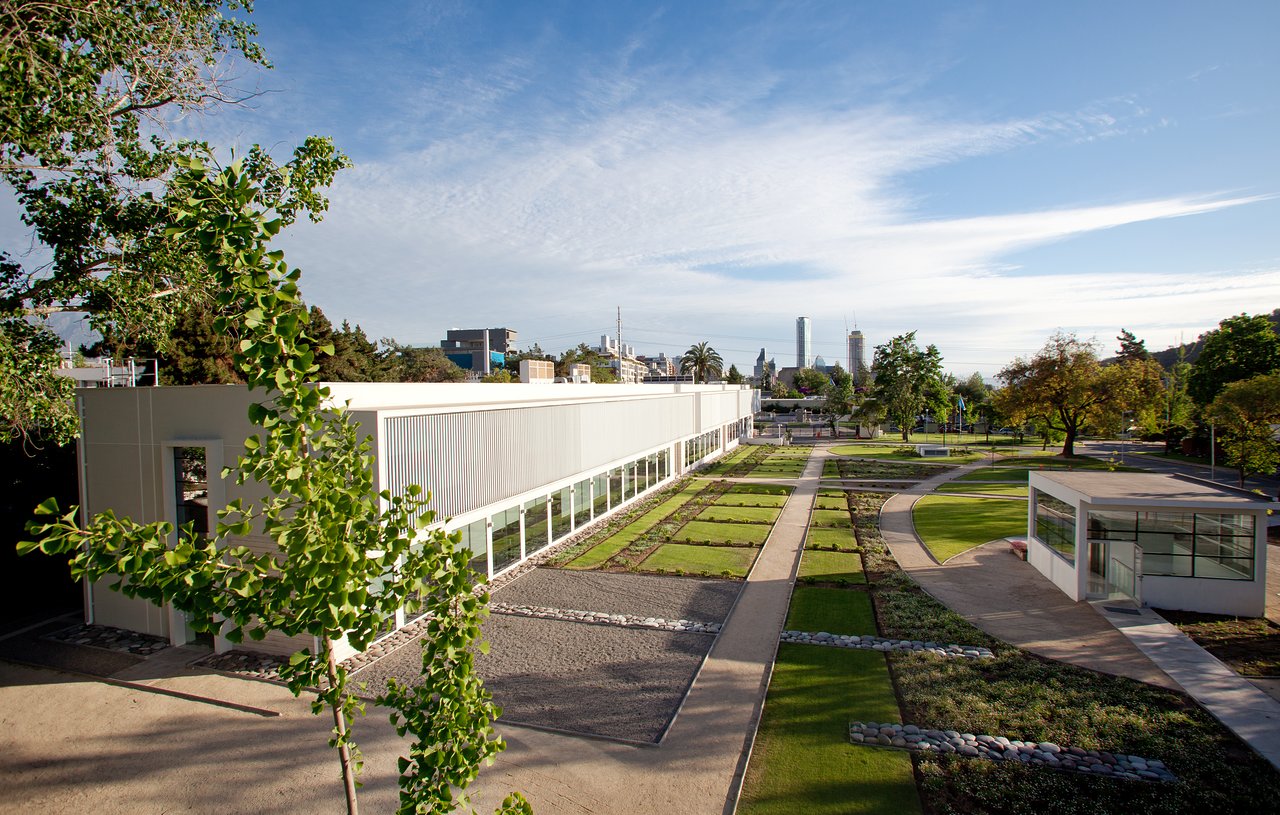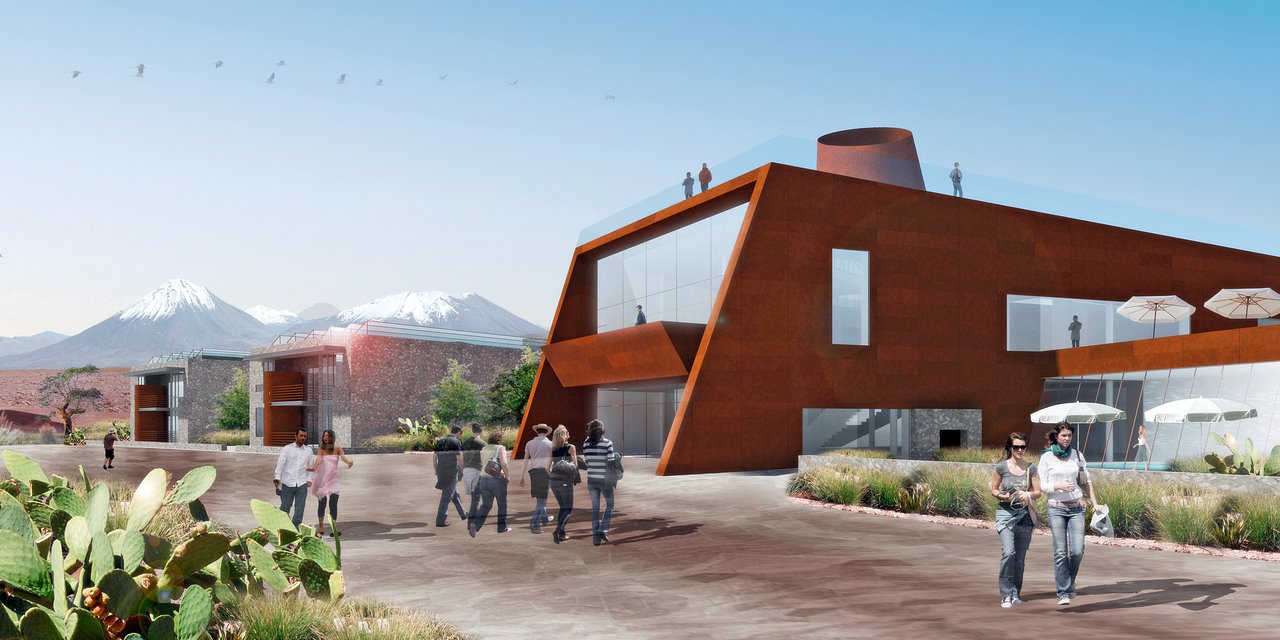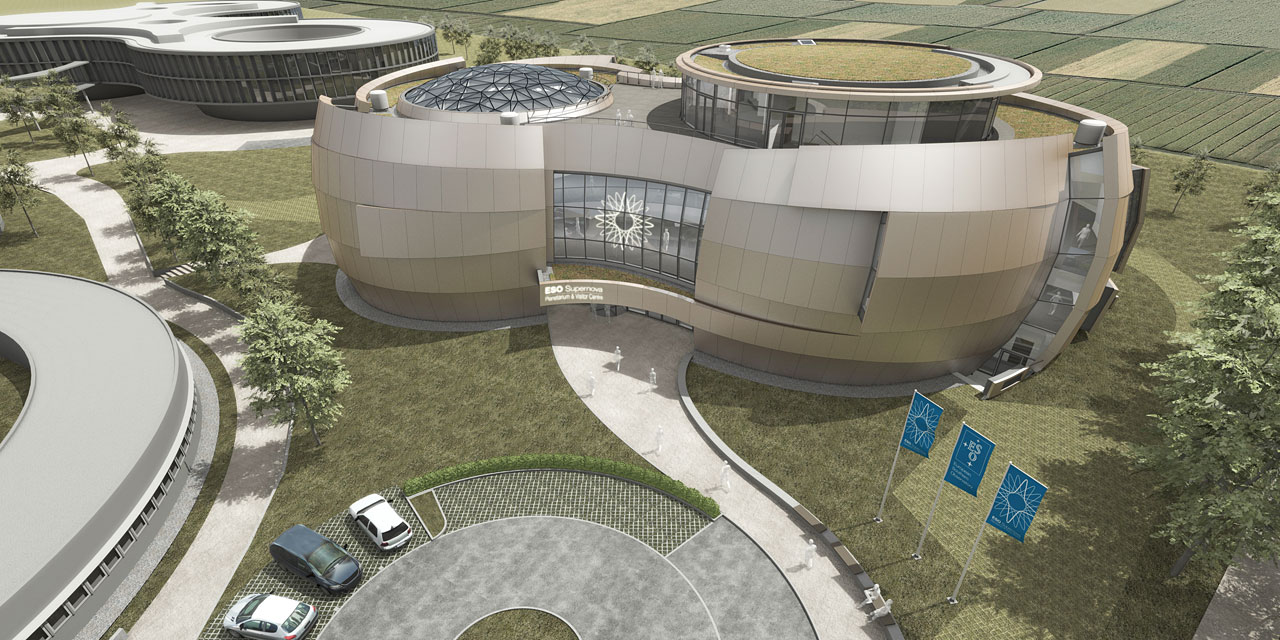Architecture at ESO
ESO is not only the foremost ground-based observatory in the world, it is also home to several architectural pearls. These include the ESO Headquarters building in Garching, Germany, and the Residencia at Paranal in Chile.
ESO Headquarters
In 1981, more than ten years after the foundation of ESO, the modernist Headquarters in Garching, Germany, were inaugurated. The Headquarters building was designed by the architects Hermann Fehling & Daniel Gogel from Berlin and it is the scientific, technical and administrative centre of ESO.
The building has a highly complex layout and geometry, primarily defined by the generous curves and lack of any 90-degree corners. When the building was first opened, an article in The ESO Messenger said: “A short period of familiarisation was needed during which everybody lost their way during a few hours or a few days in what, at first sight, looks like a labyrinth.” Fortunately ESO staff now find their way through the unusual prize-winning building without a second thought.
The building was based on a very special concept that has received worldwide attention in architectural circles. An imaginary square can be placed around the centre of the building so that the four corners mark the centres of four circles of different diameters. The various working areas at ESO are spread out over segments of these circles. The location of the rooms is organised like the buildings of a city: the library, the conference rooms and the large entrance area correspond to a town’s marketplace and are the general meeting points in the central area. All the rooms can be accessed from here via different hallways and on different levels that create a complex, three-dimensional labyrinth.

A ramp leads up to the entrance of the original ESO Headquarters building in Garching, Germany
ESO Headquarters Extension
After more than 20 years of constant growth in terms of both numbers of Member States and ESO staff, the original Headquarters became too small to host all staff members working in Garching. Therefore, the architects Auer+Weber designed an extension to the original Headquarters. The extension was inaugurated in December 2013 and features an office building, a technical building and an enclosed bridge that connects the new buildings to the original Headquarters (ann12038).
The architects chose to follow the design of the old building by adopting similar curved shapes. The two new individual buildings blend both functionally and formally with the existing Headquarters.
Circles are the dominant architectural component of the original Headquarters and are reiterated and transformed by the two new buildings. While the original building is composed of a series of open arcs, the new office building is composed of a band of convex and concave circles that enclose an inner circulation zone, and communicative and public facilities. Like the original Headquarters, the two new buildings received great attention in the architectural community and were awarded for their design (ann14028).
Since the main entrance to the original Headquarters is via a ramp at a height of about four metres above the ground, the new office building is conceived with its two floors floating above the ground level. The two main floors rest on a concrete platform that contains the functional parts of the building — the auditorium, delivery areas and covered bicycle and car parks.
Both buildings have an energy consumption that is significantly lower than is typical for buildings of this size. Details of ESO’s energy-saving programme are given on the Green ESO page.

An aerial view of ESO’s Headquarters with the two new buildings in the foreground
Office and conference building
The contours of the office and conference building, which hosts 270 workplaces and a gross floor space of about 14 000 m2, map out three overlapping circles. The offices are set around the circumference, benefiting from a great deal of natural light.
A high-tech auditorium with 234 seats can host large meetings and presentations. Furthermore, the building includes a cafeteria and a meeting room for the ESO council. These important features are situated in the area next to the existing building and thus form a balance point for the new layout on the ESO site. Additional community spaces with reading areas are arranged around two circular courtyards on both floors. One of these cut-outs has a diameter of exactly 8.2 metres — the same size as the large VLT mirrors at the Paranal Observatory.

An aerial view of ESO’s Headquarters with the two new buildings in the foreground
Technical building
In addition to the office building, the architects designed a technical building in the form of a cylinder with a diameter that matches the size of the 39.3-metre ELT mirror. The technical building has a total floor area of 2900 m2 and will host one of the largest computer archives of astronomical data in the world (as of 2015). The storage capacity of the archive will be over 1 Petabyte. To keep this computer archive and all the other valuable instruments safe, a special system of lightning rods is mounted on the roof. This precautionary measure avoids an electromagnetic pulse that could disturb sensitive instruments and measurements.
In the central assembly hall — the heart of the technical building — ESO’s most advanced instruments are assembled and tested. The assembly hall was designed with the future challenges of the ELT in mind and is large enough to build the instruments for ESO’s newest observatory, each of which will reach the size of a small house. Part of the back wall of the assembly hall can be opened, a crane can lift up to 10 tonnes and the hall can be transformed into a cleanroom. To test sensitive instruments, parts of the assembly hall can be decoupled from the rest of the building to avoid any disturbance from vibrations. Visitors can have a look at ongoing construction work in the assembly hall through a gallery on the first floor. The assembly hall is surrounded by laboratories, technical rooms and offices for engineers.
Project details
|
To make it possible for people to live and work at the remote Paranal Observatory, a lodge, known as the Residencia, was built only three kilometres from the top of Cerro Paranal, allowing astronomers to escape from the arid desert environment. Returning from long shifts at the VLT and other installations on the mountain, here they can breathe moist air and relax, sheltered from the harsh desert conditions.
The award-winning construction in concrete, steel, glass and wood was designed by German architects Auer+Weber+Assoziierte as a subterranean L-shape, with a 35-metre dome covering an indoor garden.
The prize-winning Residencia — which was was awarded the Cityscape Architectural Review Award in 2005, when it also won the Leaf-Awards — celebrated its inauguration in 2002 (eso0205). The building also featured in the James Bond movie Quantum of Solace and received worldwide attention.
The complex has four levels and fits snugly into a desert depression. By using natural materials and colours that fit perfectly into the red environment of the Atacama landscape it is almost invisible from a distance. The hotel has 18 offices and 108 guest rooms and an area of 10 000 m2. Astronomers have a spectacular view across the desert to the Pacific Ocean from their guest rooms — provided that they are not asleep during the day and the frequent clouds low over the ocean do not block the view!
The hotel also includes a canteen, music room, library, fitness centre, cinema and sauna. These provide plenty of opportunities for visitors to relax and forget about the harsh environment surrounding them. The highlight of the Residencia is a 1000 m2 indoor garden including a swimming pool — an oasis in the middle of the desert. The garden is covered by a dome that measures 35 metres in diameter, which allows sunlight to enter the Residencia from above.
The Residencia has appeared in many books on architecture such as Pulso: New Architecture in Chile, where Kenneth Frampton poetically wrote: “Some 200 metres below this summit a single four storey slab of a hotel, rendered red, extends itself into the limitless red desert, like the pristine relic of an ancient, alien civilization on the surface of the Moon.”

The Residencia at sunset with Paranal Observatory in the background
The ALMA Santiago Central Office building
The ALMA Central Office in Santiago building, the Headquarters of the Atacama Large Millimeter/submillimeter Array project, is located in the Vitacura district of the Chilean capital, on the same site as the ESO Vitacura premises.
It was built by ESO as part of its responsibilities as the European ALMA partner. The ALMA Santiago Central Office building covers nearly 7000 m2, stands two storeys tall, and includes more than 100 offices, meeting rooms, an auditorium and an underground parking area for 130 cars.
The official handover of the modern building, created by the architectural company Afaconsult, took place on 5 November 2010 (ann1083).

The Santiago Central Office Headquarters of the ALMA project
The ALMA hotel residencia
ALMA, the Atacama Large Millimeter/submillimeter Array, will soon have its own hotel for the astronomers, engineers, and other staff working at the observatory. ESO — the European partner in ALMA — is providing the accommodation and living complex for the project, and has signed a contract for the detailed design with the Finnish architects Kouvo & Partanen.
The hotel residence will be built at 2900 metres above sea level, at the ALMA Operations Support Facility in the Atacama Desert, in the foothills of the Chilean Andes. The location is close to the city of San Pedro de Atacama and the telescopes of ALMA are 28 kilometres away, at the higher altitude of 5000 metres on the Chajnantor Plateau.
The buildings’ architectural design will be integrated into the landscape by using local materials such as stone, copper and volcanic rock. Their facades and structures will use the colours and tones of the surroundings, and the natural landscape will be preserved as much as possible. The buildings are designed for energy efficiency, using natural light wherever possible, and collecting solar energy for hot water and heating. The intense sunlight has influenced the design in other ways, too: the entrances and access ways will have canopies made of local materials and natural stone, to provide protection from the strong ultraviolet radiation at this high-altitude site. The total floor area of the hotel residence will be about 5900 m2, including 120 bedrooms and the main building.
The dormitories are designed as modules, each with two sets of ten bedrooms, and individual balconies. The dormitories will branch out from a central building, which will contain numerous communal spaces. These include a lounge, dining room and an outdoor terrace. The residence will offer an environment that is both relaxing and stimulating.
The roof terrace will provide scenic views of the breathtaking landscape: the Salar de Atacama stretching below, the extinct Licancabur volcano about 35 kilometres to the north and the active Lascar volcano about 50 kilometres to the south. There will also be an observation point for stargazing with an amateur telescope.
The web page for the ALMA residencia is here.

This illustration of the ALMA hotel residence shows a view towards the main building
The ESO Guesthouse
In 1964, in parallel with the development of the La Silla site, and as Santiago became busier, the need was felt for a pied á terre for ESO’s visitors. ESO had already established an office complex on land donated by the Chilean government in Santiago’s Vitacura district, adjacent to the United Nations Economic Commission for Latin America.
A satisfactory solution for the accommodation of visiting astronomers and staff members in Chile was found by the acquisition of a colonial style house containing many rooms and surrounded by an attractive garden on a lot of 4400 m2, formerly belonging to the Spaarwater family. Situated in the Las Condes district, not far from the ESO Headquarters in Santiago, the house could easily be transformed into both offices for administration and temporary lodgings.
In its meeting of December 1964 Council approved the purchase and the transaction was concluded in March 1965, and by May, the house was being adapted to ESO’s needs. In the early 1970s, a plan to sell the Guesthouse and incorporate its function for visitors into the Vitacura Headquarters building, was mooted, but idea was not pursued any further, and to this day it remains a sanctuary of calm in the bustle of Santiago.

A 360-degree panorama of the ESO Guesthouse in Santiago
ESO Supernova Planetarium & Visitor Centre
The ESO Supernova Planetarium & Visitor Centre is a cutting-edge astronomy centre located at the ESO Headquarters in Garching near Munich, Germany. Start of the construction work was marked by a groundbreaking event on 24 February 2015 (ann15011). The heart of the ESO Supernova is a fulldome planetarium with a dome measuring 14 metres in diameter. In addition to the planetarium, the centre contains an engaging astronomical exhibition — extending over 2200 square metres — as well as two conference rooms.
The novel design of the new building resembles that of a close double-star system with one star transferring mass to its companion. This set-up will ultimately lead to the heavier component exploding as a supernova, briefly becoming as bright as the light of all the stars in the Milky Way combined.
The ESO Supernova is designed by the architects Bernhardt + Partner. Their office was established in 1994 and is located in Darmstadt, Germany. The team’s ability to design eye-catching, memorable science buildings is evident in their past projects, such as the Haus der Astronomie, and the EMBL International Centre for Advanced Training (both in Heidelberg, Germany).
The ESO Supernova is made possible by a collaboration between the Heidelberg Institute for Theoretical Studies (HITS), the research institute of the Klaus Tschira Stiftung, and ESO. The building is a donation from the Klaus Tschira Stiftung and ESO will run the facility.
For more information visit the ESO Supernova webpage.
This illustration of the ESO Supernova shows the building from the front. The ESO Headquarters Extension can be seen in the back.
Project details
|

